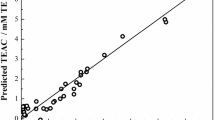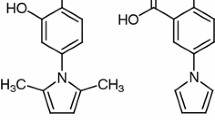Abstract
A quantitative structure–activity relationship (QSAR) study of 19 quinone compounds with trypanocidal activity was performed by Partial Least Squares (PLS) and Principal Component Regression (PCR) methods with the use of leave-one-out crossvalidation procedure to build the regression models. The trypanocidal activity of the compounds is related to their first cathodic potential (Epc1). The regression PLS and PCR models built in this study were also used to predict the Epc1 of six new quinone compounds. The PLS model was built with three principal components that described 96.50% of the total variance and present Q 2= 0.83 and R 2 = 0.90. The results obtained with the PCR model were similar to those obtained with the PLS model. The PCR model was also built with three principal components that described 96.67% of the total variance with Q 2 = 0.83 and R 2 = 0.90. The most important descriptors for our PLS and PCR models were HOMO-1 (energy of the molecular orbital below HOMO), Q4 (atomic charge at position 4), MAXDN (maximal electrotopological negative difference), and HYF (hydrophilicity index).







Similar content being viewed by others
References
Frank FM, Petray PB, Carzola SI, Muñoz MC, Corral RS, Malchiodi EL (2003) Vaccine 22:77
Ren H, Grady S, Banghart M, Moulthrop JS, Kendrick H, Yardley V, Croft SL, Moyna G (2003) Eur J Med Chem 38:949
Bauer H, Massey V, Arscott LD, Schirmer RH, Ballou DP, Williams CH (2003) J Biol Chem 278:33020
Li Z, Fennie MW, Ganem B, Hancock MT, Kobaslija M, Rattendi D, Bacchi CJ, O'Sullivan M (2001) Bioorg Med Chem Lett 11:251
Yavari I, Zabarjad-Shiraz N, Dehghan S, Roohi H, Shiri M (2002) J Mol Struct (Theochem) 589:459
Ege SN (1994) Organic chemistry structure and reactivity. D.C. Heat and Company, Lexington, MA, p 911
Ribeiro FAL, Ferreira MMC (2003) J Mol Struct (Theochem) 663:109
Geladi P, Kowalski BR (1986) Anal Chim Acta 185:1
Geladi P (1988) J Chemom 2:231
Ferreira MMC (2002) J Braz Chem Soc 13:742
Goulart MOF, Zani CL, Tonholo J, Freitas LR, de Abreu FC, Oliveira AB, Raslan DS, Starling S, Chiari E (1997) Bioorg Med Chem Lett 7:2043
Becke AD (1993) J Chem Phys 98:5648
El-Azhary AA, Sutter HUJ (1996) Phys Rev B, Solid State 100:15056
Turecek F (1998) J Phys Chem 102:4703
Frisch MJ, Trucks GW, Schlegel HB, Scuseria GE, Robb MA, Cheeseman JR, Zakrzewski VG, Montgomery JA Jr, Stratmann RE, Burant JC, Dapprich S, Millam JM, Daniels AD, Kudin KN, Strain MC, Farkas O, Tomasi J, Barone V, Cossi M, Cammi R, Mennucci B, Pomelli C, Adamo C, Clifford S, Ochterski JW, Petersson GA, Ayala PY, Cui Q, Morokuma DK, Malick DK, Rabuck AD, Raghavachari K, Foresman JB, Cioslowski J, Ortiz JV, Stefanov BB, Liu G, Liashenko A, Piskorz P, Komaromi I, Gomperts R, Martin RL, Fox DJ, Keith, Al-Laham MA, Peng CY, Nanayakkara A, Gonzalez C, Challacombe M, Gill PMW, Chen W, Wong MW, Andres JL, Head-Gordon M, Repogle ES, Pople JA (1998) Gaussian'98, Rev. A.3. Gaussian, Inc., Pittsburg, PA)
Breneman CM, Wiberg KB (1990) J Comput Chem 11:361
Wang R, Fu Y, Lai L (1997) J Inf Comput Sci 37:615
Todeschini R Milano Chemometrics and QSAR Group, Available at: http://disat.unimib.it/vhm/.
Custódio R, Andrade JC, Augusto F (1997) Quím Nova 20:219
Pimentel M, Neto BB (1996) Quím Nova 19:268
Pirouette 3.01 (2001) Infometrix Inc., Seattle, WA
Molfetta FA, Honório KM, Alves CN, da Silva ABF (2004) J Mol Struct (Theochem) 674:191
Santo LLD, Galvão DS (1999) J Mol Struct (Theochem) 464:273
Barone PMVB, Camilo A Jr., Galvão DS (1996) Phys Rev Lett 77:1186
Braga RS, Barone PMVB, Galvão DS (1999) J Mol Struct (Theochem) 464:257
Rothenberg G, Sasson Y (1999) Tetrahedron 55:561
Gramática P, Corradi M, Consonni V (2000) Chemosphere 41:763
Nelson DL, Cox MM (2000) Lehninger principles of biochemistry, 3th edn. WH Freeman, New York, p 66
Lodish H, Baltimore D, Berk A, Zipursky SL, Matsudaira P, Darnell J (1995) Molecular cell Biology. Scientific American Books, New York, p 24
Acknowledgements
The authors would like to acknowledge CAPES and CNPq (Brazilian agencies) for the financial support given to this research.
Author information
Authors and Affiliations
Corresponding author
Rights and permissions
About this article
Cite this article
Molfetta, F.A., Bruni, A.T., Rosselli, F.P. et al. A partial least squares and principal component regression study of quinone compounds with trypanocidal activity. Struct Chem 18, 49–57 (2007). https://doi.org/10.1007/s11224-006-9120-3
Received:
Accepted:
Published:
Issue Date:
DOI: https://doi.org/10.1007/s11224-006-9120-3




